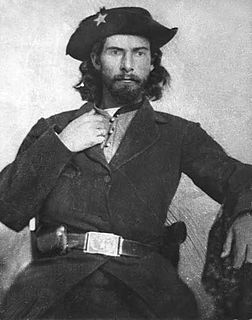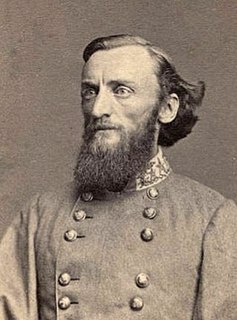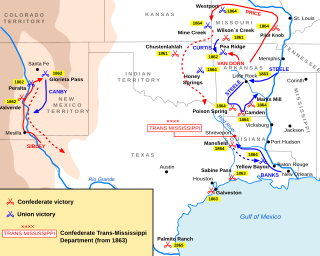
In the context of the American Civil War (1861–65), the border states were slave states that did not declare a secession from the Union and did not join the Confederacy. To their north they bordered free states of the Union and to their south they bordered Confederate slave states. Of the 34 U.S. states in 1861, nineteen were free states and fifteen were slave states. Two slave states never declared a secession or adopted an ordinance: Delaware and Maryland. Four others did not declare secession until after the Battle of Fort Sumter and were briefly considered to be border states: Arkansas, North Carolina, Tennessee and Virginia—after this, they were less frequently called "border states". Also included as a border state during the war is West Virginia, which was formed from 50 counties of Virginia and became a new state in the Union in 1863.
Quantrill's Raiders were the best-known of the pro-Confederate partisan guerrillas who fought in the American Civil War. Their leader was William Quantrill and they included Jesse James and his brother Frank.

The Battle of Wilson's Creek, also known as the Battle of Oak Hills, was the first major battle of the Trans-Mississippi Theater of the American Civil War. Fought on August 10, 1861, near Springfield, Missouri, between Federal forces and the Missouri State Guard, it is sometimes called the "Bull Run of the West."

William T. Anderson, known by the nickname "Bloody Bill" Anderson, was one of the deadliest and most notorious pro-Confederate guerrilla leaders in the American Civil War. Anderson led a band of volunteer partisan rangers that targeted Union loyalists and federal soldiers in the states of Missouri and Kansas.

The First Battle of Independence was a minor engagement of the American Civil War, occurring on August 11, 1862, in the city of Independence, located in Jackson County, Missouri. Its result was a Confederate victory, continuing the Southern domination of the Jackson County area for a few days while the recruiters completed their work.

The Battle of Lone Jack was a battle of the American Civil War, occurring on August 15–16, 1862 in Jackson County, Missouri. The battle was part of the Confederate guerrilla and recruiting campaign in Missouri in 1862.

John S. Marmaduke served as the 25th governor of Missouri from 1885 until his death in 1887. Prior to that, he was a senior officer of the Confederate States Army who commanded cavalry in the Trans-Mississippi Theater of the American Civil War. On September 6, 1863 Marmaduke killed Confederate Brigadier-General Lucius M. Walker in a duel. Major-General Sterling Price ordered Marmaduke's arrest, but suspended the order because of the impending Union advance on Little Rock, Arkansas. Marmaduke never faced a court martial for the duel.

Bushwhacking was a form of guerrilla warfare common during the American Revolutionary War, American Civil War and other conflicts in which there were large areas of contested land and few governmental resources to control these tracts. This was particularly prevalent in rural areas during the Civil War where there were sharp divisions between those favoring the Union and Confederacy in the conflict. The perpetrators of the attacks were called bushwhackers. The term "bushwhacking" is still in use today to describe ambushes done with the aim of attrition.

The Trans-Mississippi Theater of the American Civil War consists of the major military operations west of the Mississippi River. The area is often thought of as excluding the states and territories bordering the Pacific Ocean, which formed the Pacific Coast Theater of the American Civil War (1861-1865).

During the American Civil War, Missouri was a hotly contested border state populated by both Union and Confederate sympathizers. It sent armies, generals, and supplies to both sides, was represented with a star on both flags, maintained dual governments, and endured a bloody neighbor-against-neighbor intrastate war within the larger national war.

During the American Civil War, Arkansas was a Confederate state, though it had initially voted to remain in the Union. Following the capture of Fort Sumter in April 1861, Abraham Lincoln called for troops from every Union state to put down the rebellion, and Arkansas and several other states seceded. For the rest of the war, Arkansas played a major role in controlling the vital Mississippi River and neighboring states, including Tennessee and Missouri.
In the American Civil War the Home Guard or Home Guards were local militia raised from Union loyalists.

The Battle of Moore's Mill was an American Civil War battle that took place in Central Missouri on July 28, 1862 along Auxvasse Creek near modern-day Calwood. This engagement, the Battle of Kirksville a week later, and the Battle of Compton's Ferry would drive the main Southern recruiters from northern Missouri. The Moore's Mill Battlefield was added to the National Register of Historic Places in 2015.
The Missouri State Militia was a federally funded state militia organization of Missouri conceived in 1861 and beginning service in 1862 during the American Civil War. It was a full-time force whose primary purpose was to conduct offensive operations against Confederate guerrillas and recruiters as well as oppose raids by regular Confederate forces. The MSM at one time numbered more than 13,000 soldiers, but this force was reduced to 10,000 soldiers, by the United States government.
The Provisional Enrolled Missouri Militia or PEMM also known as the Detailed Militia was a state militia organization of Missouri's Union government during the American Civil War. Unlike the Enrolled Missouri Militia it was a full-time force.

Upton Hays, sometimes spelled Hayes, was a colonel of the Confederate States Army during the American Civil War.
Alexander Early Steen was a career American soldier from Missouri who served in the United States Army in the Mexican–American War. He rejoined the army in 1852 and served until he resigned to join the Confederate forces on May 10, 1861. He served as a general in the secessionist Missouri State Guard forces and as a colonel and acting brigadier general in the Confederate States Army during the American Civil War. He was killed in the Battle of Prairie Grove.
Guerrilla warfare in the American Civil War followed the same general patterns of irregular warfare conducted in 19th century Europe. Structurally, they can be divided into three different types of operations—the so-called 'People's War', 'partisan warfare', and 'raiding warfare'. Each has distinct characteristics that were common practice during the Civil War years (1861–1865).

The units of the Arkansas Militia in the Civil War to which the current Arkansas National Guard has a connection include the Arkansas State Militia, Home Guard, and State Troop regiments raised by the State of Arkansas. Like most of the United States, Arkansas had an organized militia system before the American Civil War (1861–65). State law required military service of most male inhabitants of a certain age. Following the War with Mexico (1846–48) the Arkansas militia experienced a decline, but as sectional frictions between the north and south began to build in the late 1850s the militia experienced a revival. By 1860 the state's militia consisted of 62 regiments divided into eight brigades, which comprised an eastern division and a western division. New regiments were added as the militia organization developed. Additionally, many counties and cities raised uniformed volunteer companies, which drilled more often and were better equipped than the un-uniformed militia. These volunteer companies were instrumental in the seizure of federal installations at Little Rock and Fort Smith, beginning in February 1861.
The Battle of Yellow Creek was an action during the American Civil War, occurring August 13, 1862, along the Yellow Creek in Chariton County, Missouri.






















